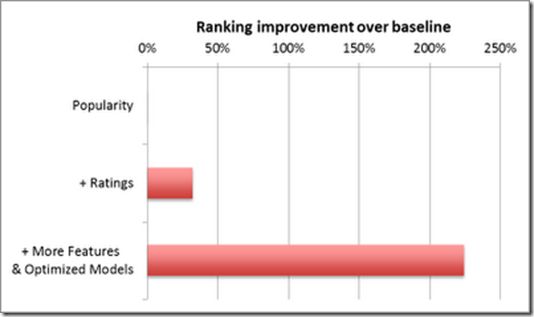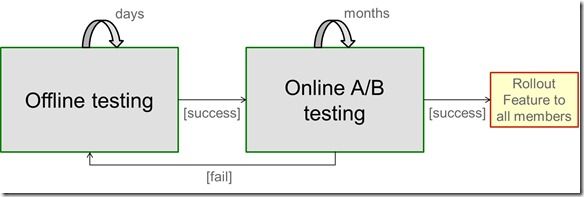Netflix Recommendations: Beyond the 5 stars (Part 2)
[Netflix的牛人Xavier Amatriain写的介绍Netflix推荐系统的一篇博客(Part 2,第一部分见上一篇转载)。原文里的图片需要FQ才能看到,感谢dang。原文链接:http://techblog.netflix.com/2012/06/netflix-recommendations-beyond-5-stars.html。]
[本文链接:http://www.cnblogs.com/breezedeus/archive/2012/08/01/2617923.html,转载请注明出处]
Netflix Recommendations: Beyond the 5 stars (Part 2)
by Xavier Amatriain and Justin Basilico (Personalization Science and Engineering)
In part one of this blog post, we detailed the different components of Netflix personalization. We also explained how Netflix personalization, and the service as a whole, have changed from the time we announced the Netflix Prize.The $1M Prize delivered a great return on investment for us, not only in algorithmic innovation, but also in brand awareness and attracting stars (no pun intended) to join our team. Predicting movie ratings accurately is just one aspect of our world-class recommender system. In this second part of the blog post, we will give more insight into our broader personalization technology. We will discuss some of our current models, data, and the approaches we follow to lead innovation and research in this space.
Ranking
The goal of recommender systems is to present a number of attractive items for a person to choose from. This is usually accomplished by selecting some items and sorting them in the order of expected enjoyment (or utility). Since the most common way of presenting recommended items is in some form of list, such as the various rows on Netflix, we need an appropriate ranking model that can use a wide variety of information to come up with an optimal ranking of the items for each of our members.
If you are looking for a ranking function that optimizes consumption, an obvious baseline is item popularity. The reason is clear: on average, a member is most likely to watch what most others are watching. However, popularity is the opposite of personalization: it will produce the same ordering of items for every member. Thus, the goal becomes to find a personalized ranking function that is better than item popularity, so we can better satisfy members with varying tastes.
Recall that our goal is to recommend the titles that each member is most likely to play and enjoy. One obvious way to approach this is to use the member's predicted rating of each item as an adjunct to item popularity. Using predicted ratings on their own as a ranking function can lead to items that are too niche or unfamiliar being recommended, and can exclude items that the member would want to watch even though they may not rate them highly. To compensate for this, rather than using either popularity or predicted rating on their own, we would like to produce rankings that balance both of these aspects. At this point, we are ready to build a ranking prediction model using these two features.
There are many ways one could construct a ranking function ranging from simple scoring methods, to pairwise preferences, to optimization over the entire ranking. For the purposes of illustration, let us start with a very simple scoring approach by choosing our ranking function to be a linear combination of popularity and predicted rating. This gives an equation of the form
frank(u,v) = w1 p(v) + w2 r(u,v) + b,
where u=user, v=video item, p=popularity and r=predicted rating. This equation defines a two-dimensional space like the one depicted below.
Once we have such a function, we can pass a set of videos through our function and sort them in descending order according to the score. You might be wondering how we can set the weights w1 and w2 in our model (the bias b is constant and thus ends up not affecting the final ordering). In other words, in our simple two-dimensional model, how do we determine whether popularity is more or less important than predicted rating? There are at least two possible approaches to this. You could sample the space of possible weights and let the members decide what makes sense after many A/B tests. This procedure might be time consuming and not very cost effective. Another possible answer involves formulating this as a machine learning problem: select positive and negative examples from your historical data and let a machine learning algorithm learn the weights that optimize your goal. This family of machine learning problems is known as "Learning to rank" and is central to application scenarios such as search engines or ad targeting. Note though that a crucial difference in the case of ranked recommendations is the importance of personalization: we do not expect a global notion of relevance, but rather look for ways of optimizing a personalized model.
As you might guess, apart from popularity and rating prediction, we have tried many other features at Netflix. Some have shown no positive effect while others have improved our ranking accuracy tremendously. The graph below shows the ranking improvement we have obtained by adding different features and optimizing the machine learning algorithm.
Many supervised classification methods can be used for ranking. Typical choices include Logistic Regression, Support Vector Machines, Neural Networks, or Decision Tree-based methods such as Gradient Boosted Decision Trees (GBDT). On the other hand, a great number of algorithms specifically designed for learning to rank have appeared in recent years such as RankSVM or RankBoost. There is no easy answer to choose which model will perform best in a given ranking problem. The simpler your feature space is, the simpler your model can be. But it is easy to get trapped in a situation where a new feature does not show value because the model cannot learn it. Or, the other way around, to conclude that a more powerful model is not useful simply because you don't have the feature space that exploits its benefits.
Data and Models
The previous discussion on the ranking algorithms highlights the importance of both data and models in creating an optimal personalized experience for our members. At Netflix, we are fortunate to have many relevant data sources and smart people who can select optimal algorithms to turn data into product features. Here are some of the data sources we can use to optimize our recommendations:
- We have several billion item ratings from members. And we receive millions of new ratings a day.
- We already mentioned item popularity as a baseline. But, there are many ways to compute popularity. We can compute it over various time ranges, for instance hourly, daily, or weekly. Or, we can group members by region or other similarity metrics and compute popularity within that group.
- We receive several million stream plays each day, which include context such as duration, time of day and device type.
- Our members add millions of items to their queues each day.
- Each item in our catalog has rich metadata: actors, director, genre, parental rating, and reviews.
- Presentations: We know what items we have recommended and where we have shown them, and can look at how that decision has affected the member's actions. We can also observe the member's interactions with the recommendations: scrolls, mouse-overs, clicks, or the time spent on a given page.
- Social data has become our latest source of personalization features; we can process what connected friends have watched or rated.
- Our members directly enter millions of search terms in the Netflix service each day.
- All the data we have mentioned above comes from internal sources. We can also tap into external data to improve our features. For example, we can add external item data features such as box office performance or critic reviews.
- Of course, that is not all: there are many other features such as demographics, location, language, or temporal data that can be used in our predictive models.
So, what about the models? One thing we have found at Netflix is that with the great availability of data, both in quantity and types, a thoughtful approach is required to model selection, training, and testing. We use all sorts of machine learning approaches: From unsupervised methods such as clustering algorithms to a number of supervised classifiers that have shown optimal results in various contexts. This is an incomplete list of methods you should probably know about if you are working in machine learning for personalization:
- Linear regression
- Logistic regression
- Elastic nets
- Singular Value Decomposition
- Restricted Boltzmann Machines
- Markov Chains
- Latent Dirichlet Allocation
- Association Rules
- Gradient Boosted Decision Trees
- Random Forests
- Clustering techniques from the simple k-means to novel graphical approaches such as Affinity Propagation
- Matrix factorization
Consumer Data Science
The abundance of source data, measurements and associated experiments allow us to operate a data-driven organization. Netflix has embedded this approach into its culture since the company was founded, and we have come to call it Consumer (Data) Science. Broadly speaking, the main goal of our Consumer Science approach is to innovate for members effectively. The only real failure is the failure to innovate; or as Thomas Watson Sr, founder of IBM, put it: “ If you want to increase your success rate, double your failure rate.” We strive for an innovation culture that allows us to evaluate ideas rapidly, inexpensively, and objectively. And, once we test something we want to understand why it failed or succeeded. This lets us focus on the central goal of improving our service for our members.So, how does this work in practice? It is a slight variation over the traditional scientific process called A/B testing (or bucket testing):
1. Start with a hypothesis
- Algorithm/feature/design X will increase member engagement with our service and ultimately member retention
- Develop a solution or prototype. Ideal execution can be 2X as effective as a prototype, but not 10X.
- Think about dependent & independent variables, control, significance…
4. Let data speak for itself
When we execute A/B tests, we track many different metrics. But we ultimately trust member engagement (e.g. hours of play) and retention. Tests usually have thousands of members and anywhere from 2 to 20 cells exploring variations of a base idea. We typically have scores of A/B tests running in parallel. A/B tests let us try radical ideas or test many approaches at the same time, but the key advantage is that they allow our decisions to be data-driven. You can read more about our approach to A/B Testing in this previous tech blog post or in some of the Quora answers by our Chief Product Officer Neil Hunt.
An interesting follow-up question that we have faced is how to integrate our machine learning approaches into this data-driven A/B test culture at Netflix. We have done this with an offline-online testing process that tries to combine the best of both worlds. The offline testing cycle is a step where we test and optimize our algorithms prior to performing online A/B testing. To measure model performance offline we track multiple metrics used in the machine learning community: from ranking measures such as normalized discounted cumulative gain, mean reciprocal rank, or fraction of concordant pairs, to classification metrics such as accuracy, precision, recall, or F-score. We also use the famous RMSE from the Netflix Prize or other more exotic metrics to track different aspects like diversity. We keep track of how well those metrics correlate to measurable online gains in our A/B tests. However, since the mapping is not perfect, offline performance is used only as an indication to make informed decisions on follow up tests.
Once offline testing has validated a hypothesis, we are ready to design and launch the A/B test that will prove the new feature valid from a member perspective. If it does, we will be ready to roll out in our continuous pursuit of the better product for our members. The diagram below illustrates the details of this process.
An extreme example of this innovation cycle is what we called the Top10 Marathon. This was a focused, 10-week effort to quickly test dozens of algorithmic ideas related to improving our Top10 row. Think of it as a 2-month hackathon with metrics. Different teams and individuals were invited to contribute ideas and code in this effort. We rolled out 6 different ideas as A/B tests each week and kept track of the offline and online metrics. The winning results are already part of our production system.
Conclusion
The Netflix Prize abstracted the recommendation problem to a proxy question of predicting ratings. But member ratings are only one of the many data sources we have and rating predictions are only part of our solution. Over time we have reformulated the recommendation problem to the question of optimizing the probability a member chooses to watch a title and enjoys it enough to come back to the service. More data availability enables better results. But in order to get those results, we need to have optimized approaches, appropriate metrics and rapid experimentation.To excel at innovating personalization, it is insufficient to be methodical in our research; the space to explore is virtually infinite. At Netflix, we love choosing and watching movies and TV shows. We focus our research by translating this passion into strong intuitions about fruitful directions to pursue; under-utilized data sources, better feature representations, more appropriate models and metrics, and missed opportunities to personalize. We use data mining and other experimental approaches to incrementally inform our intuition, and so prioritize investment of effort. As with any scientific pursuit, there’s always a contribution from Lady Luck, but as the adage goes, luck favors the prepared mind. Finally, above all, we look to our members as the final judges of the quality of our recommendation approach, because this is all ultimately about increasing our members' enjoyment in their own Netflix experience. We are always looking for more people to join our team of "prepared minds". Make sure you take a look at our jobs page.
Tags: Xavier Amatriain,Netflix Prize,Netflix,Recommendations,Beyond,Part 2




